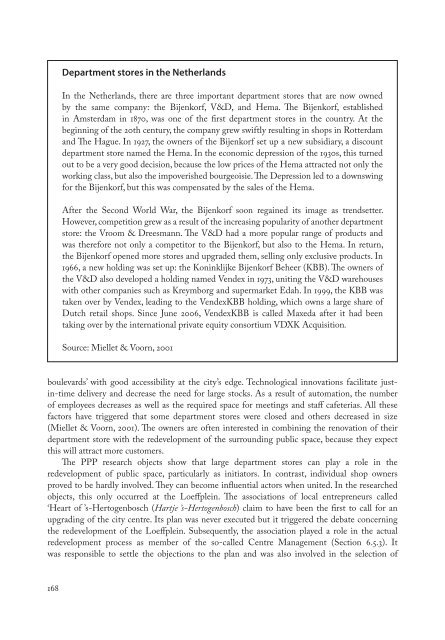Changing public space
Changing public space
Changing public space
You also want an ePaper? Increase the reach of your titles
YUMPU automatically turns print PDFs into web optimized ePapers that Google loves.
Department stores in the Netherlands<br />
In the Netherlands, there are three important department stores that are now owned<br />
by the same company: the Bijenkorf, V&D, and Hema. The Bijenkorf, established<br />
in Amsterdam in 1870, was one of the first department stores in the country. At the<br />
beginning of the 20th century, the company grew swiftly resulting in shops in Rotterdam<br />
and The Hague. In 1927, the owners of the Bijenkorf set up a new subsidiary, a discount<br />
department store named the Hema. In the economic depression of the 1930s, this turned<br />
out to be a very good decision, because the low prices of the Hema attracted not only the<br />
working class, but also the impoverished bourgeoisie. The Depression led to a downswing<br />
for the Bijenkorf, but this was compensated by the sales of the Hema.<br />
After the Second World War, the Bijenkorf soon regained its image as trendsetter.<br />
However, competition grew as a result of the increasing popularity of another department<br />
store: the Vroom & Dreesmann. The V&D had a more popular range of products and<br />
was therefore not only a competitor to the Bijenkorf, but also to the Hema. In return,<br />
the Bijenkorf opened more stores and upgraded them, selling only exclusive products. In<br />
1966, a new holding was set up: the Koninklijke Bijenkorf Beheer (KBB). The owners of<br />
the V&D also developed a holding named Vendex in 1973, uniting the V&D warehouses<br />
with other companies such as Kreymborg and supermarket Edah. In 1999, the KBB was<br />
taken over by Vendex, leading to the VendexKBB holding, which owns a large share of<br />
Dutch retail shops. Since June 2006, VendexKBB is called Maxeda after it had been<br />
taking over by the international private equity consortium VDXK Acquisition.<br />
Source: Miellet & Voorn, 2001<br />
boulevards’ with good accessibility at the city’s edge. Technological innovations facilitate justin-time<br />
delivery and decrease the need for large stocks. As a result of automation, the number<br />
of employees decreases as well as the required <strong>space</strong> for meetings and staff cafeterias. All these<br />
factors have triggered that some department stores were closed and others decreased in size<br />
(Miellet & Voorn, 2001). The owners are often interested in combining the renovation of their<br />
department store with the redevelopment of the surrounding <strong>public</strong> <strong>space</strong>, because they expect<br />
this will attract more customers.<br />
The PPP research objects show that large department stores can play a role in the<br />
redevelopment of <strong>public</strong> <strong>space</strong>, particularly as initiators. In contrast, individual shop owners<br />
proved to be hardly involved. They can become influential actors when united. In the researched<br />
objects, this only occurred at the Loeffplein. The associations of local entrepreneurs called<br />
‘Heart of ’s-Hertogenbosch (Hartje ’s-Hertogenbosch) claim to have been the first to call for an<br />
upgrading of the city centre. Its plan was never executed but it triggered the debate concerning<br />
the redevelopment of the Loeffplein. Subsequently, the association played a role in the actual<br />
redevelopment process as member of the so-called Centre Management (Section 6.5.3). It<br />
was responsible to settle the objections to the plan and was also involved in the selection of<br />
168




